As we discussed in our coverage of Samsung patents issued in recent weeks by the U.S. Patent and Trademark Office, this South Korea-based electronics corporation is a major source of innovation and one of the world’s most active patenting entities. Many of these innovations are focused on mobile technologies; the company is set to unveil the Galaxy S6 smartphone later this year, and many have been speculating about the inventive qualities of this new device. Samsung has also been lining up promotions to support flagging electronic device sales, including its recent announcement that those purchasing select Samsung devices during a two week period in January will be provided with a free one-year subscription to Netflix. Intriguing display technologies, which will discuss in more detail below, are expected to attract a great deal of attention, such as Samsung’s curved display screen for its Ativ One 7 personal computer.
Samsung’s mobile divisions have been experiencing some turbulent times but we are still seeing a preponderance of patent applications filed for mobile tech innovations. We feature a number of intriguing software systems for mobile devices, including a couple focusing on improvements to digital wallet applications. Hardware improvements for a variety of displays, including curved and flexible displays, are also featured in today’s column.
[Companies-1]
Software Innovations for Mobile Devices, Especially Financial Services
We’ve discussed Samsung’s recent issues in their smartphone and other mobile electronic device divisions in previous coverage of the electronics giant, which is why it’s interesting to see the corporation continue to pursue so much innovation in those fields. Despite restructuring of the mobile division and expectations that mobile device offerings from Samsung will diminish in number, some incredible advancements in mobile tech are still being created by the company, such as the development of a mobile payment system to rival Apple Pay which will likely be released in the first half of 2015. Samsung has also released an upgraded version of the Galaxy Note 4 mobile device which is capable of download speeds approaching 300 megabytes per second. According to a study released by the American Consumer Satisfaction Index, Samsung is actually outperforming Apple in terms of customer satisfaction in the cellular telephones industry.
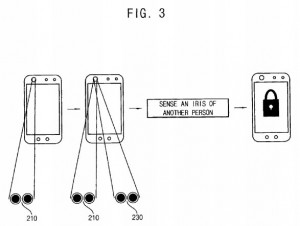 We found a myriad of patent applications claiming software methods for mobile electronic devices while scanning the recent innovations from Samsung. Techniques for preventing unauthorized viewing of private data on a mobile device through the use of gaze tracking technologies is discussed within U.S. Patent Application No. 20150003691, titled Method of Operating an Iris Recognition Portable Device and Iris Recognition Portable Device. This patent application claims a method of sensing the proximity of a second person while a first person is viewing a display screen, analyzing the second person’s iris to determine whether that person is a registered user of the device and changing the image displayed on the screen if the second person is not a registered user. This method is capable of obscuring private data on a screen so that a text or credit card information cannot be viewed by someone trying to sneak a peek.
We found a myriad of patent applications claiming software methods for mobile electronic devices while scanning the recent innovations from Samsung. Techniques for preventing unauthorized viewing of private data on a mobile device through the use of gaze tracking technologies is discussed within U.S. Patent Application No. 20150003691, titled Method of Operating an Iris Recognition Portable Device and Iris Recognition Portable Device. This patent application claims a method of sensing the proximity of a second person while a first person is viewing a display screen, analyzing the second person’s iris to determine whether that person is a registered user of the device and changing the image displayed on the screen if the second person is not a registered user. This method is capable of obscuring private data on a screen so that a text or credit card information cannot be viewed by someone trying to sneak a peek.
The detection of counterfeit bills of money through the use of components contained with a smartphone is described by U.S. Patent Application No. 20150003717, filed under the title Method of Identifying a Counterfeit Bill Using a Portable Terminal. The patent application claims a method of detecting counterfeit bills by receiving an image of a bill photographed by visible rays as well as an image of the bill photographed by infrared rays, determining the bill’s denomination, creating a corrected image using the visible ray and infrared ray photographs and comparing the corrected image to data from a genuine bill database to determine if the photographed bill is counterfeit. The simultaneous use of visible rays and infrared rays improves the accuracy of photographing a bill with a mobile device when the shakiness of a user’s hand can cause poor image quality.
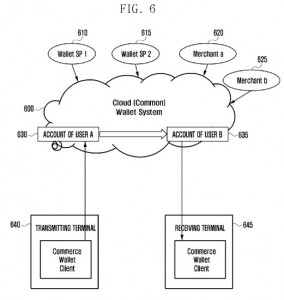 We actually were able to find a couple of patent applications filed to protect inventions related to mobile digital wallets that our readers might find interesting. The sharing of coupons, credit card information or other forms of payment between multiple wallet applications on a single device is the focus of U.S. Patent Application No. 20150006377, which is titled Method and Apparatus for Transmitting Wallets Between Mobile Devices. The method of transmitting wallet application data that would be protected involves determining the wallet application data that includes payment and non-payment information, notifying a receiving terminal of a transmission of wallet data, transmitting the wallet data and updating information of the wallet information based on preset regulation information.
We actually were able to find a couple of patent applications filed to protect inventions related to mobile digital wallets that our readers might find interesting. The sharing of coupons, credit card information or other forms of payment between multiple wallet applications on a single device is the focus of U.S. Patent Application No. 20150006377, which is titled Method and Apparatus for Transmitting Wallets Between Mobile Devices. The method of transmitting wallet application data that would be protected involves determining the wallet application data that includes payment and non-payment information, notifying a receiving terminal of a transmission of wallet data, transmitting the wallet data and updating information of the wallet information based on preset regulation information.
This method of sharing wallet data between applications enables users to manage their digital wallet services through a single application instead of using multiple applications for different stores. A similar kind of technology is at the center of U.S. Patent Application No. 20140379569, titled Method and Apparatus for Combining Different Kinds of Wallets on a Mobile Device. This patent application claims a method of combining a plurality of wallet applications for a commercial transaction service by acquiring both payment and non-payment information provided by a plurality of wallet applications and providing combined wallet data through a combining application. This invention also combines wallet data information, particularly to enable a user to access mobile credit card information so that a wallet application can be used in a store to make a credit transaction without the use of a physical credit card.
[Companies-3]
Hardware Improvements for Electronic Devices, From Displays to Energy Harvesters
Samsung has also been pursuing hardware innovations that help to increase the functionality of their mobile devices. The company recently announced the development of an 8 gigabyte dynamic random-access memory (DRAM) chip developed for large screen, ultra high definition mobile devices. Many recent Samsung innovations have also focused on the exterior of mobile devices; there has been much speculation, for instance, about the inclusion of curved screen displays in the Galaxy S6 device that will be officially unveiled later this year.
 We managed to stumble across a Samsung innovation that involves display methods that would allow for the inclusion of curved displays on various devices in U.S. Patent Application No. 20150002531, which is titled Image Processing Method and Apparatus for Curved Display Device. It claims a method of processing an image for curved displays by acquiring physical curvature information related to the display device, determining a center region of an input image based on that information, generating a pixel-by-pixel spatial indexed gain based on the determined center region and correcting a pixel value of the input image by utilizing the pixel-by-pixel spatial indexed gain. This system reduces the risk that contour or noise artifacts, which degrade image quality, develop due to nonlinear characteristics of an image displayed on a curved screen.
We managed to stumble across a Samsung innovation that involves display methods that would allow for the inclusion of curved displays on various devices in U.S. Patent Application No. 20150002531, which is titled Image Processing Method and Apparatus for Curved Display Device. It claims a method of processing an image for curved displays by acquiring physical curvature information related to the display device, determining a center region of an input image based on that information, generating a pixel-by-pixel spatial indexed gain based on the determined center region and correcting a pixel value of the input image by utilizing the pixel-by-pixel spatial indexed gain. This system reduces the risk that contour or noise artifacts, which degrade image quality, develop due to nonlinear characteristics of an image displayed on a curved screen.
Samsung Display Co., another leading Samsung patenting entity, has its own display innovations filed with the USPTO through U.S. Patent Application No. 20140361262, entitled Flexible Display Device and Method of Fabricating the Same. The flexible display device claimed here is comprised of a substrate with both a foldable bending region and a non-foldable non-bending region, a plurality of pixels disposed on the bending region; the pixels of the bendable region are spaced at a different interval than pixels that are disposed on the non-bending region. This improved pixel array increases the resistance of bendable displays to cracks and other mechanical defects during use.
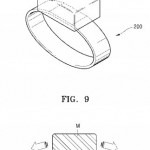 We were very intrigued to learn of a device designed to generate electricity from the motion of smart watches in order to support longer battery life in those devices. U.S. Patent Application No. 20150001993, entitled Energy Harvester Using Mass and Mobile Device Including the Energy Harvester, claims an energy harvester with multiple substrates spaced apart from each other, both of which are provided with electrodes, where one of the substrates is connected to a mass. An energy generator is provided between the electrodes on either substrate that generates electrical energy upon a relative movement of the two substrates caused by a movement of the mass.
We were very intrigued to learn of a device designed to generate electricity from the motion of smart watches in order to support longer battery life in those devices. U.S. Patent Application No. 20150001993, entitled Energy Harvester Using Mass and Mobile Device Including the Energy Harvester, claims an energy harvester with multiple substrates spaced apart from each other, both of which are provided with electrodes, where one of the substrates is connected to a mass. An energy generator is provided between the electrodes on either substrate that generates electrical energy upon a relative movement of the two substrates caused by a movement of the mass.
Other Samsung Patent Applications: Electronic Chalkboards and Vehicle Surveillance
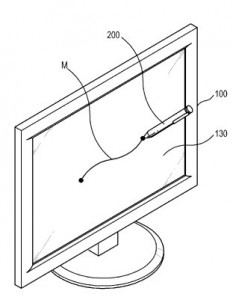 We’ll wrap up our discussion of Samsung’s patent applications with a couple of other innovations that may pique the interests of our readers. Digital technologies in the classroom will be impacted by the innovation laid out within U.S. Patent Application No. 20150002412, titled Image Erasing Device for Electronic Chalkboard System, Control Method Thereof, Display Apparatus, Control Method Thereof, and Electronic Chalkboard System. The erasing device for erasing an image from a display claimed here has a housing with a tip having a plurality of tip portions which emit an electromagnetic field created by a generator. A control unit included in the erasing device controls the generator to emit the electromagnetic field when the tip touches the surface of the display. This device and system allows an electronic chalkboard user to easily erase an image from the chalkboard display without having to reset the entire panel.
We’ll wrap up our discussion of Samsung’s patent applications with a couple of other innovations that may pique the interests of our readers. Digital technologies in the classroom will be impacted by the innovation laid out within U.S. Patent Application No. 20150002412, titled Image Erasing Device for Electronic Chalkboard System, Control Method Thereof, Display Apparatus, Control Method Thereof, and Electronic Chalkboard System. The erasing device for erasing an image from a display claimed here has a housing with a tip having a plurality of tip portions which emit an electromagnetic field created by a generator. A control unit included in the erasing device controls the generator to emit the electromagnetic field when the tip touches the surface of the display. This device and system allows an electronic chalkboard user to easily erase an image from the chalkboard display without having to reset the entire panel.
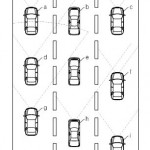 Our attention was also caught by an impressive system designed to capture road condition information and recognizing vehicle license plates for an integrated road control system. U.S. Patent Application No. 20140375813, which is titled Integrated Control System and Method Using Surveillance Camera for Vehicle, claims an integrated control method using a vehicle surveillance camera by receiving vehicle license plate number obtained by analyzing an image captured by the vehicle surveillance camera, receiving time and position information about the image and constructing a database for all of the information gathered. The database created through the metadata collected by event data recorders, or black boxes, used by automobiles increases the efficiency of integrated road control systems for detecting road conditions, like accidents and traffic congestion, by reducing the communication traffic of such systems.
Our attention was also caught by an impressive system designed to capture road condition information and recognizing vehicle license plates for an integrated road control system. U.S. Patent Application No. 20140375813, which is titled Integrated Control System and Method Using Surveillance Camera for Vehicle, claims an integrated control method using a vehicle surveillance camera by receiving vehicle license plate number obtained by analyzing an image captured by the vehicle surveillance camera, receiving time and position information about the image and constructing a database for all of the information gathered. The database created through the metadata collected by event data recorders, or black boxes, used by automobiles increases the efficiency of integrated road control systems for detecting road conditions, like accidents and traffic congestion, by reducing the communication traffic of such systems.

![[IPWatchdog Logo]](https://ipwatchdog.com/wp-content/themes/IPWatchdog%20-%202023/assets/images/temp/logo-small@2x.png)

![[Advertisement]](https://ipwatchdog.com/wp-content/uploads/2024/04/Artificial-Intelligence-2024-REPLAY-sidebar-700x500-corrected.jpg)
![[Advertisement]](https://ipwatchdog.com/wp-content/uploads/2024/04/UnitedLex-May-2-2024-sidebar-700x500-1.jpg)
![[Advertisement]](https://ipwatchdog.com/wp-content/uploads/2024/04/Patent-Litigation-Masters-2024-sidebar-700x500-1.jpg)

![[Advertisement]](https://ipwatchdog.com/wp-content/uploads/2021/12/WEBINAR-336-x-280-px.png)
![[Advertisement]](https://ipwatchdog.com/wp-content/uploads/2021/12/2021-Patent-Practice-on-Demand-recorded-Feb-2021-336-x-280.jpg)
![[Advertisement]](https://ipwatchdog.com/wp-content/uploads/2021/12/Ad-4-The-Invent-Patent-System™.png)






Join the Discussion
No comments yet.